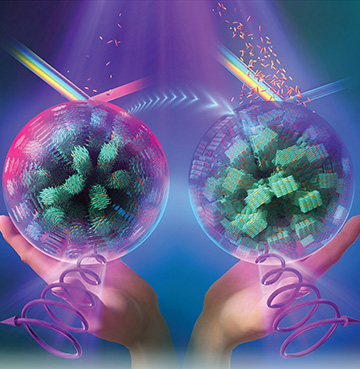
Researchers at Nagoya University, Japan, have chemically coaxed cholesteric liquid crystals into a potential anticounterfeiting-tag system that uses both circularly polarized luminescence/structural color and UV fluorescence for two-step verification. [Image: ACS Publications / Nagoya University]
A research team in Japan has tweaked the chemistry of cholesteric liquid crystals (CLCs) to devise a clever potential two-step platform for anticounterfeiting (ACS Appl. Mater. Interf., doi: 10.1021/acsami.4c08331). By treating the CLCs with fluorescent dyes and adjusting the level of a dopant that affects the crystals’ chirality, or sense of twist, the team’s approach in principle could be used to simultaneously test for authenticity using two different forms of light-based encoding: UV-induced fluorescence, and structural-color features revealed only under circularly polarized visible light.
The researchers believe their “sophisticated dual-verification system” could offer “enhanced anticounterfeiting protection for high-value items.”
Leveraging CPL
Circularly polarized luminescence (CPL) is a prime example of a “chiro-optical” phenomenon. In CPL, the relative intensity of right or left circularly polarized light emitted from a material varies depending on the material’s chirality—the “right- or left-handedness” of its molecules’ sense of twist. The prospect of putting CPL to work in applications such as data storage, biosensing and optical displays has prompted a search for polymers or other materials whose chirality can be controlled and inverted by external stimuli, such as light, temperature or pH, or by chemical means, such as doping.
The researchers behind the new work, led by Yukikazu Takeoka of Nagoya University, wanted to see how the ability to invert chirality and, consequently, CPL might expand the application palette for one kind of material in particular: fluorescent CLC microspheres. These are nematic liquid crystals with a helical structure that imparts chirality to the molecules. According to the authors, these CLCs “can exhibit not only brilliant structural colors but also remarkable fluorescent colors under certain conditions.”
Chemistry lesson
The team reasoned that putting fluorescence and structural color together with adjustable circularly polarized luminescence might offer an intriguing way to boost anticounterfeiting protection.
The team reasoned that putting these qualities together with adjustable CPL might offer an intriguing way to boost anticounterfeiting protection. To get there, the researchers spent a lot of time in the chem lab, refining and optimizing a tricky three-component system.
The researchers first created the fluorescent CLC particles themselves. To do that, they polymerized a fluorescent dopant with monodisperse CLC microspheres that exhibit chiral structural color (that is, structural color visible under only right- or left-handed circularly polarized light), developed using a method the team had reported last year. The team then added a third component to the mix—a chiral dopant, to provide a knob for direct control of the CLC molecules’ handedness. The result was collection of CLC particles that exhibited both CPL and circularly polarized structural color under visible light, and fluorescence under UV light.
One complication was that both the fluorescent dopant and the chiral dopant might have an impact on the material’s CPL. To root out that impact, the team painstakingly tested the influence of the relative dopant combinations on the fluorescent CLCs’ optical properties and physical structure, using scanning electron microscopy, polarized optical microscopy and CPL spectroscopy.
Dual-verification system
The analysis of the three-component system allowed the team to adjust the fluorescent- and chiral-dopant concentrations to reach a sort of goldilocks combination—one in which the crystals’ CPL chirality is inverted, but their structural-color chirality is left unchanged. That combination, coupled with the material’s fluorescence, opened the door to testing a novel two-factor anticounterfeiting scheme.
To run the test, the researchers created a 2×2-cm QR code in PVC film, laid on top of a colored base layer of chirally doped CLCs. A second, hidden password is also drawn into the film using the fluorescent CLCs.
Under normal lighting, according to the authors, the QR code remains concealed because “the human eye cannot differentiate between chiral and achiral structural colors.” Hence, in non-circularly-polarized light, the code is indistinguishable from the colored background CLC layer. Under left-polarized light, however, the QR code is revealed behind the overlying film—“serving,” the team writes, “as the first decryption key.” The QR code routes the user to a specific webpage, access to which can be gained only by shining UV light on the film; this causes the password inscribed in it to fluorescently glow and become visible—“the second decryption key.”
“The correct information is revealed only when both decoding tools—left circularly polarized light and ultraviolet light—are employed,” Takeoka said in a press release accompanying the research. “This dual-layer security significantly enhances the protection offered by existing CLC-based anti-counterfeiting tags.”
